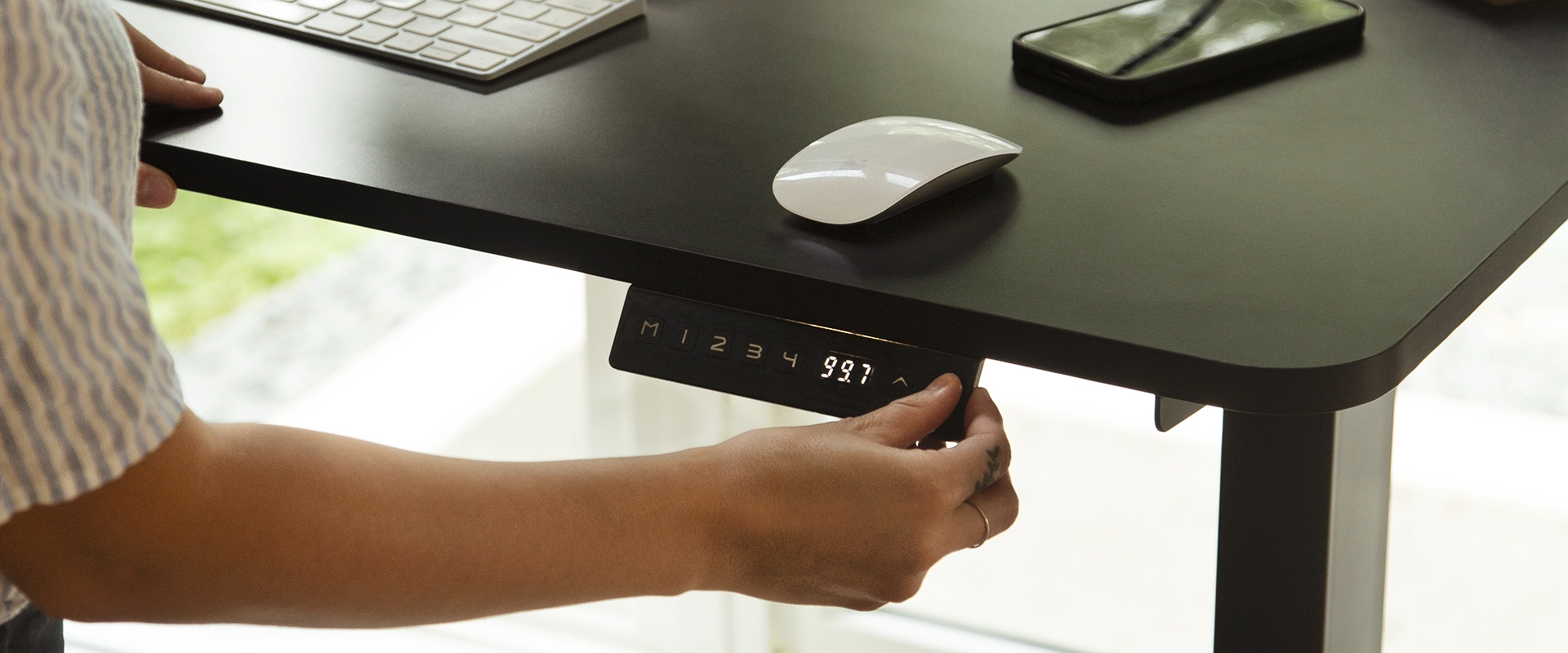
Get a new desk or chair for your work from home setup

Standing desks have gained popularity as a healthier alternative to traditional sitting desks. It’s essential to maintain proper posture and optimize your workstation when using one. We will go over guidelines for setting up your standing desk for better health and comfort. If you follow these easy standing desk posture tips and guidelines, your body will thank you.

Ensuring your desk is at the optimal height is crucial for keeping proper posture. Stand up straight, with your feet shoulder-width apart, and bend your elbows at a 90-degree angle. Position the desk at elbow level or right below, making necessary adjustments. Proper desk height prevents unnecessary strain on your shoulders, neck, and back.

The monitor’s position plays a significant role in maintaining proper posture. Place the monitor at arm’s length, with the screen at or slightly below eye level. Use a monitor riser or stand, if necessary, to achieve the correct height. Tilt the monitor back 10-20 degrees to reduce glare and prevent neck strain. This will ensure a comfortable viewing angle.
An anti-fatigue mat provides cushioning and support for your feet. This will help reduce stress on your legs and lower back. Standing on a hard surface for extended periods can lead to discomfort and fatigue. Anti-fatigue mats encourage subtle movements in your leg muscles. They promote better circulation and reduce the pressure on your joints. I’ve been using an anti-fatigue mat for the past 2 years, and it’s a game changer!
Place your keyboard and mouse close together and ensure that your elbows are close to your body. This prevents leaning forward which can cause strain on your shoulders and neck. An ergonomic keyboard and mouse setup is essential for maintaining proper posture. It will also prevent discomfort while working at a standing desk.

To avoid discomfort and strain, stand tall with your head, shoulders, and hips aligned. Keep your weight evenly distributed on both feet. Tuck in your stomach muscles to engage your core, and relax your shoulders. Avoid hunching or rounding your shoulders forward, which can lead to poor posture and discomfort.
Standing in one position for too long can cause fatigue and discomfort. It’s essential to take breaks and change positions regularly. Alternate between sitting and standing every 30 minutes to an hour. Make sure to take short walks or do light stretches during your breaks.
Wearing supportive shoes while working at a standing desk will impact your posture. Choose shoes with proper arch support and avoid high heels or flat shoes with little to no support. Proper footwear not only enhances comfort but also promotes better posture. Supportive footwear reduces strain on your feet, legs, and lower back. I wear On or Hoka running shoes when I’m working at my standing desk.
Use adjustable monitor arms, keyboard trays, document holders, and vertical mice for comfort and better posture. These items reduce neck, shoulder, and wrist strain when using a standing desk. Customizing your workspace helps maintain correct posture and prevents discomfort.
Try balance boards, standing desk exercises, and set reminders to move during the day. Movement and activity help relieve muscle fatigue, keep good posture, and boost well-being. Adding these activities to your daily routine makes standing workstations more enjoyable.

Place your desk near a window for natural light, or use adjustable task lighting. Make sure you try to reduce monitor glare, or wear blue light glasses. Adjust your monitor’s brightness and contrast to lessen eye strain. Good lighting will increase comfort, productivity, and lowers the risk of vision issues.
Add plants, personal items, and photos to make your standing desk more enjoyable. A pleasant work environment encourages proper posture and mental health. Personalization will make your home office a productive oasis.
Check your comfort and posture at your standing desk daily. Evaluating progress identifies areas for improvement, ensuring proper posture and ergonomics. Making adjustments over time leads to long-term comfort and health benefits.
If you have trouble maintaining proper posture, consult an ergonomist or occupational therapist. They give personalized advice to optimize your workspace. They will give you the tools to promote good posture and well-being while working from home.
Talk about standing desk experiences with coworkers who also use standing desks. Sharing best practices creates a supportive work environment and encourages healthier habits. Shared knowledge benefits everyone’s comfort and productivity.
Standing desks offer many health benefits if you maintain proper posture. Not following ergonomic guidelines can result in injury and an unproductive work environment. By following these standing desk posture tips and guidelines, you’ll create a comfortable, productive, and healthier workspace.
Learn More
Learn More
Contact Us
Read Story
Sign up for our newsletter to get
updates straight to your inbox.
We’re Here To Help
Available Monday through Friday, 9am to 6pm EST.
Learn More
Learn More
Contact Us
Read Story